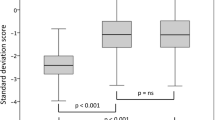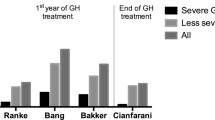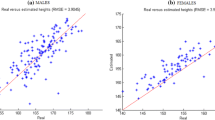Abstract
Background: GH therapy response varies substantially among patients. Several models were developed to predict the efficacy of GH therapy in children. Aim: To evaluate the accuracy of a growth prediction model using data from an Italian pediatric GH deficiency (GHD) cohort (GeNeSIS, Growth Prediction Sub-study). Methods: Open-label, multicenter study in 22 Italian pre-pubertal GH treatment-naïve patients with GHD (8 female, 14 male, 0.5 to 12.2 yr), 18 isolated GHD, 4 multiple pituitary hormone deficiency given recombinat human GH therapy (0.025–0.035 mg/kg/day) for 12 months. Growth prediction was performed, after 3 months of treatment, using baseline data [bone age (BA) and IGF-I], a urinary marker of bone turnover [deoxypyridinoline crosslinks (DPD)] at 4 weeks, and height velocity (HV) at 3 months. Results were expressed as 1st-yr HV using the following equation: 1-yr HV (cm) = 3.543 − (2.337 × BA) − (0.010 × IGF-I) + (0.100 × DPD) + (0.299 × 3-month HV). Predictions were compared to the 1st-yr HV and accuracy was calculated as percentage of the difference between mean calculated HV and the real 1st-yr HV. Results: For females predicted HV was 12.98±4.82 cm/yr and actually was 13.05±3.91 cm/yr after the 1st year; for males predicted HV was 13.95±5.39 cm/yr and actually was 12.93±5.02 cm/yr. Conclusions: In this paediatric Italian cohort with GHD, a growth prediction model seems to be a valid tool to assess 1st-yr response to GH treatment in Italian children.
Similar content being viewed by others
References
Growth Hormone Society. Consensus Guidelines for the diagnosis and treatment of growth hormone (GH) deficiency in childhood and adolescence: summary statement of the GH Research Society. GH Research Society. J Clin Endocrinol Metab 2000, 85: 3990–3.
Hindmarsh PC, Dattani MT. Use of growth hormone in children. Nat Clin Pract Endocrinol Metab 2006; 2: 260–8.
Ranke MB, Lindberg A, Chatelain P, et al. Derivation and validation of a mathematical model for predicting the response to exogenous recombinant human growth hormone (GH) in prepubertal children with idiopathic GH deficiency. KIGS International Board. Kabi Pharmacia International Growth Study. J Clin Endocrinol Metab 1999, 84: 1174–83.
Wikland KA, Kriström B, Rosberg S, Svensson B, Nierop AF. Validated multivariate models predicting the growth response to GH treatment in individual short children with a broad range in GH secretion capacities. Pediatr Res 2000, 48: 475–84.
Schönau E, Westermann F, Rauch F, et al. German Lilly Growth Response Study Group. A new and accurate prediction model for growth response to growth hormone treatment in children with growth hormone deficiency. Eur J Endocrinol 2001, 144: 13–20.
Land C, Blum WF, Shavrikova E, Kloeckner K, Stabrey A, Schoenau E. Predicting the growth response to growth hormone (GH) treatment in prepubertal and pubertal children with isolated GH deficiency — Model validation in an observational setting (GeNeSIS). J Pediatr Endocrinol Metab 2007, 20: 685–93.
Tanner JM, Whitehouse RH. Clinical longitudinal standards for height, weight, height velocity, weight velocity, and stages of puberty. Arch Dis Child 1976, 51: 170–9.
Greulich W, Pyle S. Radiographic Atlas of Skeletal Development of the Hand and Wrist. Palo Alto, CA: Stanford University, 1959.
Ogden CL, Kuczmarski RJ, Flegal KM, et al. Centers for Disease Control and Prevention 2000 growth charts for the United States: improvements to the 1977 National Center for Health Statistics version. Pediatrics 2002, 109: 45–60.
Blum WF, Breier BH. Radioimmunoassays for IGFs and IGFBPs. Growth Regul 1994, 4 (Suppl 1): 11–9.
Blethen SL, Compton P, Lippe BM, Rosenfeld RG, August GP, Johanson A. Factors predicting the response to growth hormone (GH) therapy in prepubertal children with GH deficiency. J Clin Endocrinol Metab 1993, 76: 574–9.
Spagnoli A, Spadoni GL, Cianfarani S, Pasquino AM, Troiani S, Boscherini B. Prediction of the outcome of growth hormone therapy in children with idiopathic short stature. A multivariate discriminant analysis. J Pediatr 1995, 126: 905–9.
Kriström B, Jansson C, Rosberg S, Albertsson-Wikland K. Growth response to growth hormone (GH) treatment relates to serum insulin-like growth factor I (IGF-1) and IGF-binding protein-3 in short children with various GH secretion capacities. Swedish Study Group for Growth Hormone Treatment. J Clin Endocrinol Metab 1997, 82: 2889–98.
Author information
Authors and Affiliations
Corresponding author
Rights and permissions
About this article
Cite this article
Valle, D., Bartolotta, E., Caruso, M. et al. Prediction of response to growth hormone treatment in pre-pubertal children with growth hormone deficiency. J Endocrinol Invest 34, e126–e130 (2011). https://doi.org/10.1007/BF03346720
Accepted:
Published:
Issue Date:
DOI: https://doi.org/10.1007/BF03346720




